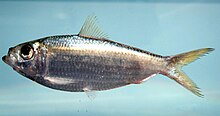Scaled sardine
| Scaled sardine | |
|---|---|

| |
| Scientific classification | |
| Kingdom: | |
| Phylum: | |
| Class: | |
| Order: | |
| Family: | |
| Genus: | |
| Species: | H. jaguana
|
| Binomial name | |
| Harengula jaguana Poey, 1865
| |
The scaled sardine, Harengula jaguana, is a herring-like fish in the family Clupeidae. It is native to coastal waters of the western Atlantic Ocean, from the Gulf of Mexico (where it is known as the pilchard or whitebait) down to Brazil where it is called mata.
It has a solid back with dark streaks and usually a small dark spot at the upper edge of the operculum and sometimes one located at the shoulder. It grows up to 9 inches (23 cm) in length but typically is little more than half that size.
It is a fast-growing species, living only 12 to 18 months.
Scaled sardines are often referred to by anglers as greenbacks. They can usually be caught with strings of wire loops known as minnow rings, sabiki rigs or by cast netting.
References
- Froese, Rainer; Pauly, Daniel (eds.) (2006). "Harengula jaguana" in FishBase. May 2006 version.
